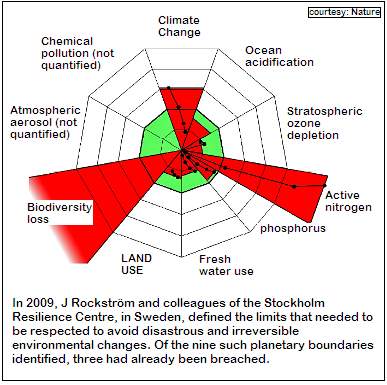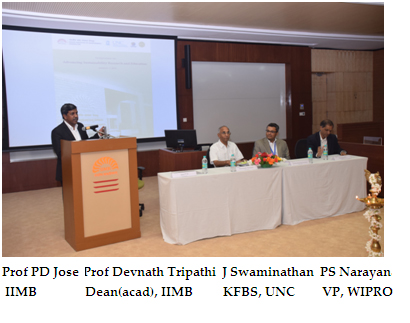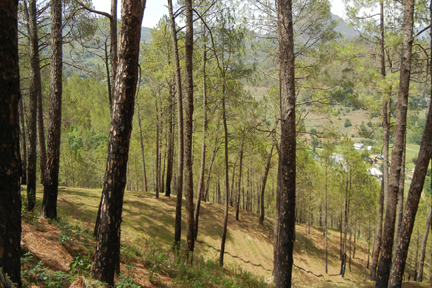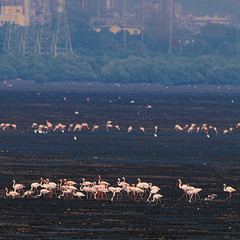Adventure
Press this week
Kejriwal promises to shut Okhla waste plant
Govt fails to use green cess to protect environment
She made no-polythene zone a reality
Solar lights to ward off tigers at Sundernbans' villages
The two sides of eucalyptus in The Nilgiris
and many more ........at
|
Burning Issues
Biofuels - messiah or myth?
Bio-fuels, once seen as the alternative for scarce petroleum, have limitations that prevent their extensive use, says S.Ananthanarayanan.
The 1970s were years of innocence - we became aware of the fuel crisis, but we did not suspect global warming. It was only in 2006, that Al Gore, with his documentary, ‘An inconvenient truth’ brought it home to many that the earth may never be the same
again.
Global warming is the awful truth about human activity, largely in the last century and most of all in the last few decades Bio-fuels, once seen as the alternative for scarce petroleum, have limitations that prevent their extensive use, which has pumped
CO2 (mostly) and some other gases, which trap heat, into the atmosphere. And this has set into motion a rapid rise in global temperature, leading to melting of polar ice caps and many large glaciers, soon to lead to rise in the sea levels and unpredictable
changes in weather in all parts of the world.
Apart from rise in CO2 from burning coal for electricity and petroleum for transport, to cater to a growing world population, the same population is also making large demands for food, to be provided by farmland and pasture for livestock. Agriculture,
industry and housing needs are hence also encroaching on forests and other areas of greenery, and eliminating the engines of fixing atmospheric CO2 back into oxygen. It is estimated that increased use of land for food crops would soon cross the so called planetary
boundary, or the limit that would lead to irreversible changes.

But, at the time of the oil crisis in the 1970s, when the Arabs realized that oil will not last forever, we believed that the problem was one of finding alternatives to petroleum. France, with negligible coal reserves, accelerated her nuclear programme
and stopped all use of oil for power generation. But for other alternatives to the use of oil for transport and also electricity generation, the discovery of bio-fuel, or motor spirit derived from organic matter, appeared to be a Godsend. But, while nations
rushed to maximize this new messiah, other realities, for one, that even cleaner fuel, like bio-fuel, added CO2 to the atmosphere, and then, that cultivation of plants for bio-fuel would eat into limited land, which was needed for food crops, soon became apparent.
Dr Running from the University of Montana, in Missoula, USA starts with an existing estimate of the total vegetable matter created all over the earth by fixing carbon with the help of sunlight, through photosynthesis. This figure, without a correction
for the portion used by the plants themselves, is estimated with the help of satellite data of the amount of light absorbed in wavelengths that are used in photosynthesis, all over the earth. The absorption would obviously vary from place to place and according
to the season, but the average comes to about 53 billion tonnes, on land, and about the same in the sea. As the biomass created in the sea is consumed by organisms in the sea, what is left is only the part created on land.
Not all this biomass, however, is available for humans to use. Some 28% is biomass created as the root structure underground. Some 24% is in the wilderness, including national parks, and is either out of reach or not desirable to exploit. Of what is left,
some 80% is being used by humans for food, fibre and fuel, and only about 5 billion tonnes, out of 53 billion, is left, and may be the reserve for population increase expected in the coming decades.
But now, Dr Running notes, there is a competitor for this last 5 billion tonnes, in the form of bio-energy. Bio fuels are largely based on grain which is fermented to create methanol, or from fats to create bio-diesel, to be used in place of or along with
petrol or diesel to run IC engines, and bio-fuels now account for under 10% of the total energy produced and consumed in the world. But then, if the world pushes up the prices of energy, as it must, then many energy producing agencies may like to shift from
fossil fuels to bio-energy, which would lead to massive bio-mass farming.
“The energy markets can out-compete the food markets financially, so bio-energy production could replace food production on a large enough scale to disrupt the current economics of agriculture and even generate food shortages. The ethanol fuel goals of
the U.S, government doubled the commodity price of corn from around $2 to $4 per bushel in the last half dozen years, disrupting the global corn market. It is easy to imagine that any major development of bio-energy could be on a collision course with global
food security,”Dr Running says.
The next point that Dr Running makes is what good would all the use of biomass for energy do? All the remaining 5 billion tonnes of biomass, if used for energy, would be able to create less than 20% of the energy being used. Creating any more energy than
that would call for biomass cultivation to eat into existing agricultural land or into wilderness and forest reserves, which would affect the earth’s carbon fixing capacity and biodiversity.
But there are still ways to manage bio-energy so that it does not erode food supplies, says Dr Running. A good part of the bio-energy potential is from agricultural and forest residues and municipal trash. While all the figures are estimates, it may not
be far wrong to say that ways could be found to generate a fourth of our energy needs from bio-mass, he says. But this would need careful design of a bio-energy and food production policy, for optimum division of biomass between electricity generation and
producing ethanol and for allowing a part of crop residues to remain as nutrient for the next year’s crop.
(To read more articles by popular science writer S.Ananthanarayanan, visit http://www.simplescience.in)
|
Corporates and Environment
Polluting Coal
When it comes to fighting industry pollution, most of us are like the sleeping owl. Close your eyes against realities but open them only in the night, when you can see what you want to see - food.
When Centre for Science and Environment brought out their green ratings for the coal industry, the audience in the packed room listened to a well researched and field based analysis of India's thermal power stations.
With State pollution control boards understaffed to monitor performance, power plants routinely flout norms ; nevertheless the plants almost always report compliance. Is it a surprise then that NTPC, the biggest of them all refused to be scrutinized by CSE,
citing compliance of norms?
Coal based electricity entails heavy costs on the environment, resources and health. It is responsible for significant emissions of harmful particulate matter, in addition to discharge of coal ash which needs to be
recycled/disposed off safely as it has toxic heavy metals. NTPC's Badarpur Power Station is spread over 874 hectares, of which 362 hectares has been used to dispose of waste.
JSEB Patratu, had an unacceptably high emission of CO2. The effluent bearing oil and ash from JSEB, Patratu flows into the River Nalkari.
Photo Sanjeev Kanchan
In sharp contrast, CESC, Budge Budge in West Bengal, who earned a three leaf rating from CSE, uses 76 per cent of total ash for cement and bricks. The plant sells its fly ash to cement manufacturers in Bangladesh.
CESC, Budge Budge, supplies dry ash directly into barges to send it to cement plants in Bangladesh (Photo: Sanjeev Kanchan)
JSWEL-TORANAGALLU POWER plant in Karnataka and TATA-TROMBAY POWER plant also qualified for three green leaves.
Sanjoy Chakraborti, Executive Director at Budge Budge said " We consider environment protection as an integral part of our power generation process". He said revenue started improving after they started recycling
and reusing waste with environment protection in mind.
Sanjoy Chakraborti of Budge Budge
Sanjay Sagar, Joint Managing Director & Chief Executive Officer, JSW Energy Limited said how proud the team at his company feels when people say theirs is a power unit set in a resort, a compliment to the intensive
tree plantation efforts made by them in the factory compound.
Coal based power plants generated 173 million tonnes of ash in 2013-14. Given the grave risks ash poses, Union Environment Ministry has set a target of 100% ash utilization from 2014 on wards.
|
Environment Education
Sustainable Curriculum
In January 2015, Indian Institute of Management, Bengaluru conducted a three day symposium on ‘Advancing Sustainability Research and Education’. The initiative was in collaboration with the Kenan-Flagler Business School, University of North Carolina and
was funded by the Obama-Singh 21st Century Knowledge Initiative, Asim Premji’s WIPRO was a co-sponsor, through Earthian, its sustainability engagement programme, and they hosted a part of the proceedings in their premises.
Green science in business
Global warming effects were discovered in the 19th century, but it was in 1988 that scientists formally confirmed that heat-trapping gasses in the atmosphere, released by humans and industry, were causing grave damage to the environment. The same year,
the Intergovernmental Panel on Climate Change (IPCC) was set up under the United Nations, and in 1992, Governments of the world came together in Rio de Janeiro to decide on what was to be done. One of the first things decided was that all countries maintain
National Greenhouse Gas Inventories, to help monitor progress. The next accord was the Kyoto Conference of 1995, where emission control targets were set, at least for the developed nation, which included Australia, the EU and some others. These were valid,
in the first instance, from 2007 to 2012. The targets have been refined and detailed in different conferences and at the next major international meet, to take place later in 2015, in Paris, more specific, comprehensive measures to contain the global rise
in temperature within 2°C may be decided. This 2°C limit is seen as the level of warming that people and the environment can accommodate, with reasonable adaptation.
But what is alarming is that for all the conferences, parleys and the mass of data collected by scientists, the growth of CO2 in the atmosphere is apace. Much of the reductions reported by developed countries is misleading, as the countries have reduced
manufacture within their own borders, but have shifted industry to other places, like China or India (see box). Underdeveloped countries think the west has ‘recognised’ their capability and is ‘investing’, and manufacture and consumption are peaking. The earth
is seen to have clearly breached three of the ten ‘planetary boundaries’ set by the Stockholm Resilience Centre, and the last report of the IPCC is emphatic that the 2°C target is unrealistic, at best. It may be more optimism than reason to hold that there
is still a ‘window of opportunity’ till 2030 to get things under control.
Business steps in
The World Business Council for Sustainable Development (WBCSD) is an association of over 200 international companies, which thinks private enterprise can and must supplement the role of governments in dealing with climate change. WBCSD then provides a
platform for business to share knowledge and best practices, and motivation, to pursue sustainable development. At first glance, it may be ironic that profit-driven commerce, which leads the charge against the environment, should act to rein itself in. But,
business does have a vested interest and can act as a powerful driver of reform. “business is responsible too….you cannot do good business in a failed planet,” says Peter Becker, President of WBCSD.
ACTION2020 is a programme devised by WBCSD to apply business solutions to attain environmental and societal targets. “Through collaboration toward common goals, business can address some of the critical…… problems the world faces, while strengthening their
own resilience to global challenges,” says ACTION2020. Business schools, which train managers in using formal scientific techniques to isolate and overcome challenges of resources, personnel and markets, have been pressed to use their competence to launch
business as a positive force. Academic research is counted on to devise solutions that are measurable, so that we know they are working, scalable, so that they can be positioned to have global impact and, replicable and enabling collaboration of different
sectors. And most of all, solutions that are good for business, by redesign of processes, supply chains, consumer preferences, so that having the least impact on the environment still makes business sense
IIM, Bengaluru and the Kenan-Flagler Business School, which have run a sustainability module in their MBA programmes since the year 2000, partnered to get the movement going in India. The symposium at Bengaluru aimed to showcase both research that would
impact sustainability concerns as well as curriculum content in management institutes to sensitise managers and society of the need for new thinking. The participants were teachers and researchers from leading management institutes, universities, centres of
economic research, in India and abroad, engineering colleges, stake holders like the Forrest Institute and other interested sections, communicators, even a theatre person.

The papers presented covered different areas of sustainability and social responsibility in the working of industries, research into sustainability at stages of the supply chain, using sustainability for brand equity, effectiveness of international accords,
public policy, energy efficiency, case studies of interventions to promote indigenous, rural and low income industries, social equity, and the social web. And one of the three days of the symposium was dedicated to ways and efficacy of including sustainability
as a component of management education.
On a realistic note, the Director of IIM/Indore emphasized that his institute was neither drawn by the ‘pull’ of the industry to train students in sustainability nor driven by a ‘push’ of students seeking such training. This undeniable truth, in fact,
stated the problem, and hence the need and urgency to open eyes in industry and society. At the same time, a completed study that was circulated to participants was specifically to the effect that in a sample of the leading ICT companies worldwide, limited,
though the sector is, it was in the most successful of the companies that the highest incidence of sustainability issues engaging the attention of senior managers and the board was found.
Setting the stage
Vijay Padaki, hon. President of Bangalore Little Theatre Foundation, presented a short play, performed by students of IIMB, during the symposium, which conveyed powerfully the message of the mess that the world has landed in. The play was an adaptation
of a 1920 Chech science fiction play, whose title translates as Rossum’s Universal Robots. The original play was about rebellion of artificial humanoids created for ‘forced labour’, the original meaning of the word, robot. The adaptation of the play featured
modern day robots which are able to think almost like humans and are programmed to protect humans at all costs.
When the robots see that humans have started to destroy the planet and endanger their own existence, the robots conclude that humans are their own worst enemy, who hence need to be destroyed. The action is set partly in the robot factory shop-floor and
partly in the board room of the robot factory, and pure, mechanical objectivity of the robot conclusion, based on evidence before us all, that humans need to be destroyed for their own protection, conveyed the message of environment cost of current lifestyle
more powerfully than any classroom pedagogy.
Padaki said there were now genres of theatre which could convey basic and current science, which opens the possibility of art forms, in general, to be used for science and environment awareness.
|
General
FOREST FIRES
DIPANJAN GHOSH
Forest fire is a natural part of the circle of forest life in most types of forests and grasslands of the world. Both fire and forest are intimately and intricately related to each other. Natural sources like lightning, volcanic eruption, etc., can cause
forest fires. Lightning induced fires are quite common in boreal forests where the forest floors are rich in raw humus deposits and with minimal microbial activities.
Fires in the forest are classified in to three categories. Ground fire or muck fire spreads very slowly and occurs beneath the top soil. They may continue to burn for months and destroy vegetative cover of the soil. Creeping or surface fire, usually spreads
slowly over the forest floor, burning with a low flame. Surface fire may spread rapidly by wind over the vegetation of the lower canopy composed of grasses, herbs and shrubs. Crown fire is the most unpredictable fire that consumes the entire upper canopy of
a forest.
Dry deciduous forest and grassland ecosystem of Eastern Himalaya is in conflagration during the dry season (Photo: Souvick Mukherjee).
In India, forest fire is a seasonal phenomenon that occurs mainly in grasslands and various types of forest compositions. For instance, Himalayan montane forest vegetation and shola grassland ecosystem of the Western Ghats encounter fire incidence in regular
intervals, mostly during the dry season. However, fires can occur in rainforests too, but under very extreme weather conditions.
Sometimes fires are set on to the forest to improve the quality of pasture land and to create fresh grass growth for cattle; to facilitate the collection of various forest produce such as tender leaves, honey, lichens, dry grasses and seeds. Moreover,
smugglers and poachers burn forest area to have more visibility and to avoid encounter with wild animals. Sometimes people set fire to scare away wild animals from villages and agricultural fields.
Controlled fire or swailing is a technique used as a genuine wild land management measure and are performed by trained personnel under the supervision of forest department, mainly in United States, Canada and Australia. In Kaziranga National Park of Assam,
the grasslands are burnt every year. Also there are some dry forests in South India where patches are burnt by forest department along roadsides to increase their efficiency as fire breaks in case of wildfire.
Certain plants must have fire at regular intervals in order to regenerate (Photo: Ayan Mondal).
Controlled burning or prescribed burning reduces the possibilities of wild fires. Clearing leaf litters, dropped branches, inflammable grasses, and ground vegetation from the forest floor with low intensity controlled fires can help in preventing furious
wildfire incidents that spread out of control and completely damage forests.
Fire has several positive as well as negative ecological impacts. Low intensity fire that does not grow out of control has collective advantages to the ecosystems and its various species. Forest fire removes low-growing undergrowth and small tree species
as well as cleans the forest floor of debris. Fire opens up forests so that sunshine can get through which encourage plants to grow. Forest fire perpetuates certain fire dependent plant species and also helps in regeneration (Figure 2). Besides, certain conifers
are serotinous, i.e., they open cones to disperse seeds after getting heat from fire. Wild fire, though indomitable, determines the spread of the vegetation in certain areas. For instance, the composition of the vegetation at all altitudes in the Himalayas
has been much figured by fires (Figure 3). Many forest trees struggle against certain pathogenic or non-pathogenic diseases and insect infestations. Forest fire kills harmful pests, parasites, fungi as well as invasive weeds and keeps the forest healthy.
 Blue pine (Pinus wallichiana) habitat in a post-burn forest of Central Himalayas (Photo: Dipanjan Ghosh).
Forest fire results a huge outcome of smoke due to biomass burning (Photo: Souvick Mukherjee).
Forest fire causes a huge outcome of smoke, mainly due to large scale biomass burning (Figure 4). Various gases of biogenic origin such as carbon dioxide, carbon monoxide, methane, non-methane hydrocarbons, nitrous oxide, and nitric oxide are produced
by such burning incidents. In fact, forests generally maintain the balance of gases like oxygen and carbon dioxide in the atmosphere. However, the gases generated due to forest fire not only pollute the atmosphere but also contribute to green house effects
and global warming.
Blackbuck (Antilope cervicapra) on open grassland in Velavadar NationalPark, Bhavnagar, Gujarat. The native bunchgrass and herbs grow fast after a fire which gives the antelope plenty of food to eat (Photo: Aisharya Sridhar).
Most of the animals remain unharmed as they can take temporary shelter in unburnt or already burnt areas. Fires burn the eggs of birds, destroy the young animals and damage their habitats. As habitat is burnt some animals are unable to move to other areas,
due to unfamiliarity. Birds take advantage of their flight to escape fire. Snakes, lizards and some small mammals avoid the fire by taking refuge in deep underground burrows and crevices. Surprisingly, some non-burrowing animals are killed by suffocation,
when trapped inside smoke laden burrows or pits. Some cold blooded animals including snakes are seen to bask in burnt areas where the ground is warm. Burning of thick grasses affects both prey and predator, as cover for both is lost.
(Basically a teacher by profession, Dipanjan Ghosh is equally well-known popular science writer and one of the Editors of the journal ‘Indian Science Cruiser’ published from Kolkata. E-mail to: dpanjanghosh@gmail.com for sharing
your views.
Postal Address: Chotonilpur Pirtala, PO Sripally, Dist. Bardhaman 713 103, West Bengal.)
|
Nature and wellness
Purify air quality inside homes with plants
-Dr.Susan Sharma
There is so much talk about Delhi being the most polluted city in the world now. While air quality outside is bad, quality of air inside our homes is also not good. The common pollutants are formaldehyde: in carpets, upholstery, glues, paint, and more;
benzene: in plastics, synthetic fibers, lubricants, rubber, pesticides, and more); trichloroethylene: in paint removers, rug cleaning solution, adhesives, and more
There are many powerful air-cleaning plants that naturally remove pollutants from the air.
In a 2,000 square foot house, bring in 15 to 20 plants in 6-inch pots or larger. Rather than scattering single plants, create group displays in each room for a great look and maximum air quality. Which are the plants you can consider? Here are some
common ones.
1. Chrysanthemum
This plant can be noted for its popularity as an indoor houseplant in part because of its air cleaning qualities as per a study done by NASA, removing benzene, formaldehyde, and ammonia and other chemicals from the air. It’s popular and inexpensive, plus
chrysanthemums can be planted outside too.
A graceful member of the chrysanthemum family
2. Spider Plant
Spider plants are incredibly easy to grow, so if you’re a beginner, this is a great one to start with. It sends out shoots with flowers on them that will eventually grow into baby spider plants that you can propagate yourself. Before too long, you’ll
have more spider plants than you’ll know what to do with. They are known to remove formaldehyde, xylene and toluene from the air around.
Spider plant
3. Dracaena
There are over 40 kinds of dracaena plants, which makes it easy to find the right one for you. They remove benzene, formaldehyde, trichloroethylene, and xylene from the air. They are toxic to cats and dogs though, so if you have pets, you might want to
think twice about this one.
Dracaena
4. Ficus
Ficus trees are capable of growing quite large depending on the type of pot you have them in. They typically stand between 2 and 10 feet tall and have some serious air cleaning abilities. You can also keep it outside in the spring and summer. The ficus
removes benzene, trichloroethylene and formaldehyde from indoor air.
Tray garden with ficus as the main tree
5. Snake Plant/Mother-in-law’s Tongue
You see this one all over the place in offices and restaurants – and for good reason. They’re pretty much impossible to kill. They need water only occasionally and prefer drier conditions. They don’t need much direct sunlight either. They remove benzene,
formaldehyde, trichloroethylene and xylene from indoor air.
Motherinlaw plant inside a house
Will come back with more in our next issue!
|
Our choice from Flickr this month
Flamingoes
IndianWildlifeClub Flickr page started in 2005. Over the years it has got 1104 members who have contributed 15,754 photographs. This is a veritable pool of information for a citizen scientist. We would welcome analysis
of these photographs from a conservation angle by our members.
We have attempted a simple study looking at flamingo photos over the years. Following the pics from 2008 till date, we found that no.of photos from the year 2012 were fewer. Just go to https://www.flickr.com/groups/iwc/pool/
and search the photos. Start asking questions? why?, where? when?

Feb 2008

Nov 2009

May 2010

May 2011

2013
Look closely and you may find interesting insights into the movement of flamingoes on India's coasts.
In the early 1990s, flocks of greater and lesser flamingos started migrating to Mumbai, arriving in late October or early November, and staying until the end of May, when the monsoon begins, says Mr. Asad Rahmani of
BNHS.
Environmentalists and bird enthusiasts do not know whether the flamingos come from the Rann of Kutch in Gujarat, or Kenya and Tanzania in East Africa, said Mr. Rahmani. But the reason why they come is more obvious, the abundance of food and physical protection
here, he added.
|
Press on environment and wildlife
1. Chambal river, protected by a curse, faces the modern world
2. Winds of change hit green energy sector
3. HC bans immersion of idols, bathing in Udaipur lakes
4. Climate Change
5. Camp on environment conservation in Hubballi
6. Corporation set up for Swachh A. P. mission
7. Garbage disposal goes hi-tech
8. Polluted lake behind Tughlaqabad Ft: HC notice to ASI, SDMC,
9. Puducherry municipality to restrict dumping of garbage
10. Agra groundwater has high fluoride content ..............................................
Read details at
http://indianwildlifeclub.com/MediaCenter/Press-Releases.aspx
|
Wilderness Volunteers
A request to IWC members
This request is going out to all IWC members but in particular to those members who have done online environment courses with BNHS.in any of the four following programs.
Leadership in Biodiversity
Herpetology
Ornithology
Entomology
This mail is also directly addressed to the volunteers who worked with WRCS during 2013-14.
We plan to publish stories of people who worked for environment conservation in NGOs in the last one year in either waste management, clean energy, Bio-diversity or wildlife protection. The work can be either as volunteers, project managers or short
term employment. We would like to hear in your own words the experiences of working in these fields. You can send in upto 300 words with upto five photographs in .jpg format (photographs must be sent separately).
You are also welcome to send in quiz programs (ten questions with three choice of answers). You can have a look at our quiz page for guidance in format and content. We do not encourage purely academic questions.
Please also send in contact information of NGOs for which you worked and if it is willing to engage more volunteers.
a. Contact details
Name of Organisation to be displayed:
Website of the Organisation:
Name of Contact person:
b. Organisation Profile
Brief description of kinds of Projects undertaken: (CSR projects for corporates/central government projects/local projects /others )
List of current and upcoming projects :
Location of your projects: what is local and what would require people to travel to remote locations.
Duration of Projects:
Strength of staff in your organisation(permanent & temporary):
c. Expectations from Volunteers
How frequently do they need volunteers in the near future?
What kind of profile of volunteers/people is required? (Skilled/unskilled- to be trained/ unskilled- no traning required)
d. A brief write-up of the organisation that you would like to showcase:
Please send the details by email to Dr.Susan Sharma at susan_sharma@hotmail.com copy to Mr.Sushant Gupta at
sushant_gupta3@hotmail.com
|
WildlifeQuiz
Last month's quiz received three all correct answers. Here are the results of the n Quiz on Deer and Antelopes, which our server threw up.
tarunprovat@gmail.com, sabinajayapalan@gmail.com and agrisubin@gmail.com
The first to reach us was tarunprovat@gmail.com. Congrats and expect a surprise gift from us!
Now, attempt a Quiz on Coastal Regulation Zone(CRZ) in India at
http://indianwildlifeclub.com/Quiz/Quiz.aspx?qid=39
You can try the quiz more than once. Email ids of all those who give all ten correct answers will be published. The server will pick up a winner at random from among these who will be eligible for a surprise gift.
|